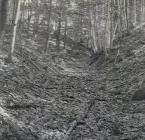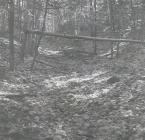1
Nine Mile Portage site, from the head of Kempenfeldt Bay to Nottawasaga Rivercirca 1955
Barrie, Ontario, Canada
 Credits:
Credits:Museum of Ontario Archaeology
2
Wilf wrote in his autobigraphy that the town of Barrie was getting very envious of watching all of the archaeological and historical developments taking place in neighboring Huronia, seeing streams of tourists and school groups bypassing Barrie en route to Midland or Penetanguishene. The Barrie Chamber of Commerce approached Wilf and Elsie in 1954 with the idea of trying to develop some archaeological sites in the Barrie area as tourist attractions or educational facilities similar to those being developed in Huronia.At that time, the Barrie Chamber of Commerce had no specific project in mind, they just wanted Wilf and Elsie to find something of interest. Local residents and history buffs had long known of the Nine Mile Portage. The protage began at the head of Kempenfeldt Bay at the southwest corner of Lake Simcoe (where Barrie is now located) and followed an overland route west-northwest to Willow Creek and the Nottawasaga River flowing northward into Lake Huron. They were also aware of the existence of "Fort WIllow" along this route, but virtually no work had been done to properly document either the route or the fort. This seemed like an ideal subject to pursue through further archival research and archaeological investigation: WIlf and Elsie took up the challenge. Sporadically over the next few years, they completely traced the portage route and excavated and partially reconstructed Fort Willow. They also undertook further research and excavation at Schoonertown.
